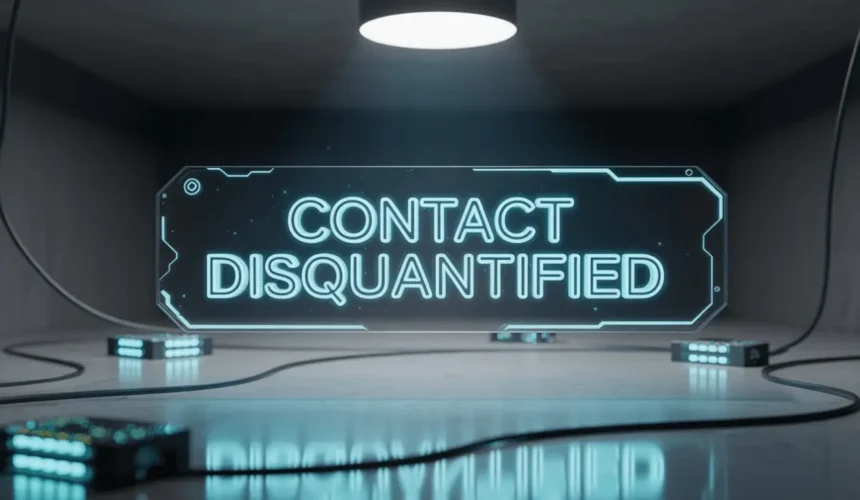In the ever-evolving world of business communication, the term contact disquantified is gaining attention for its relevance to data management, customer engagement, and lead qualification. While the phrase may sound complex at first, it plays a crucial role in modern sales and marketing workflows. Understanding what it means, why it matters, and how it impacts decision-making can help businesses streamline their processes and achieve better results.
What Does Contact Disquantified Mean?
At its core, contact disquantified refers to the process of removing or flagging a contact that no longer meets the criteria for engagement or sales qualification. In many organizations, customer relationship management (CRM) systems are used to categorize leads based on factors such as interest, budget, and readiness to buy. When a contact fails to meet these standards, they are considered disqualified, or in this case, disquantified.
This process ensures that teams focus their efforts on leads that have a higher chance of converting into customers. In other words, contact disquantified serves as a filter that separates potential opportunities from low-priority or irrelevant ones.
Why Businesses Use Contact Disquantified
The concept is not just a technical term; it has significant practical implications. Businesses often receive hundreds or even thousands of inquiries, form submissions, or newsletter sign-ups. Without a system to prioritize these contacts, teams risk wasting time on unqualified leads. By implementing a clear contact disquantified strategy, organizations can:
- Save time by avoiding outreach to unqualified prospects
- Reduce marketing costs by focusing campaigns on high-quality audiences
- Improve conversion rates by targeting the right people
- Keep CRM data clean and organized for future use
Transitioning from a generic lead pool to a qualified list makes sales teams more efficient and marketing efforts more impactful.
The Role of Technology in Contact Disquantified
Modern CRMs and marketing automation platforms make it easier than ever to implement contact disquantified strategies. These tools use scoring models and workflows to automatically assess whether a lead should stay in the pipeline or be removed.
For example, a company might set rules where only contacts with a certain level of engagement, such as opening multiple emails or visiting specific product pages, remain in the active list. Those who do not meet these conditions are automatically tagged as disquantified.
This automated approach reduces human error and ensures that teams have access to the most relevant data at all times. It also allows businesses to re-engage disquantified contacts later if their behavior changes, ensuring no potential opportunity is permanently lost.
Benefits of Contact Disquantified for Marketing Teams
From a marketing perspective, a well-structured contact disquantified process can significantly improve campaign performance. When email lists and ad audiences consist of people who are more likely to convert, engagement rates naturally rise.
This approach also prevents the negative effects of low-quality leads, such as high email bounce rates or low click-through rates, which can damage sender reputation and reduce overall deliverability. By maintaining a qualified list, marketers can create personalized campaigns that resonate with the right audience.
Common Mistakes to Avoid
While contact disquantified offers many advantages, it must be used carefully. Some businesses make the mistake of disqualifying leads too early, missing out on potential long-term opportunities. For instance, a contact who is not ready to purchase today might still be a valuable prospect in the future.
To avoid this pitfall, companies should implement nurturing campaigns that keep disquantified contacts engaged over time. Educational emails, targeted content, and periodic check-ins can help re-qualify these leads when they become ready to buy.
Best Practices for Implementing Contact Disquantified
A successful approach requires a balance between automation and human judgment. Here are some best practices to follow:
- Define clear criteria for when a contact should be considered disquantified.
- Use lead scoring models that take into account engagement, demographics, and intent.
- Automate the process with CRM tools but review results regularly to ensure accuracy.
- Maintain a re-engagement plan so that no potential lead is lost permanently.
By following these steps, businesses can keep their data clean while still maximizing future opportunities.
Future Trends in Contact Disquantified
As artificial intelligence continues to advance, we can expect even more sophisticated ways to handle contact disquantified processes. Predictive analytics and machine learning models will soon be able to identify which contacts are likely to convert long before traditional metrics can detect it.
This evolution will give businesses a competitive edge, allowing them to allocate resources with greater precision and improve overall customer experience.
Final Thoughts
In an increasingly competitive market, focusing on the right contacts is essential. The concept of contact disquantified helps businesses filter out unqualified leads, save resources, and boost conversion rates. When implemented thoughtfully, it becomes a powerful tool for both sales and marketing teams, ensuring that every effort is directed toward high-value opportunities.
Companies that invest time in refining their disqualification criteria and using the latest technology to support the process will see measurable improvements in efficiency, revenue, and customer satisfaction.







